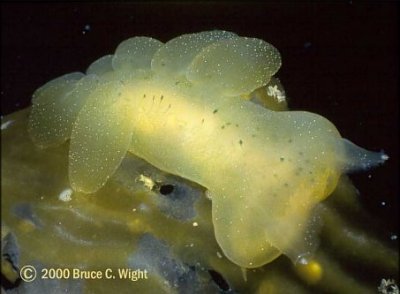
Melibe leonina
(Gould, 1852)
Order: NUDIBRANCHIA
Suborder: DENDRONOTINA
Family: Tethydidae
DISTRIBUTION
West coast of North America from Alaska to Baja California.
PHOTO
Northern Channel Islands, San Miguel Island, California. Lower left showing egg mass. Photos: Bruce C. Wight.
Species of the genus Melibe have a large expandable oral hood which is fringed with sensory tentacles and used to catch small crustacea. The large flattened leaf-like cerata are easily detached if the animal is disturbed, and animals are often found with some or all the cerata missing or in a state of regrowth. M. leonina grows to about 90mm long and seasonally found in large numbers on kelp and sometimes 'swimming' in coastal waters.
"Melibe leonina has a a sweet fruity aroma which you can smell throughout the room when a number of them are in a tank. It tends to 'get to you' like a bad perfume. They are gregarious animals and probably use it to keep together." See Sandra Millen's message.
See separate pages for references, and information on other species M. engeli and M. viridis.
Reference:
• Gould, A.A. (1852). United States Exploring Expedition during the years 1838-1842. Mollusca and Shells, 12: I-XV, 1-510


Rudman, W.B., 2000 (September 2) Melibe leonina (Gould, 1852). [In] Sea Slug Forum. Australian Museum, Sydney. Available from http://www.seaslugforum.net/find/melileon
Related messages
Nudibranch odors
December 10, 2009
From: Rick Harbo
A sign at a local aquarium stated that the nudibranch Melibe leonina smells like a watermelon.
Do nudibranchs have distinctive odors, like sea stars, that can be used as identifying features?
Rick Harbo
Nanaimo, B.C. Canada
rharbo@shaw.ca
Harbo, R., 2009 (Dec 10) Nudibranch odors. [Message in] Sea Slug Forum. Australian Museum, Sydney. Available from http://www.seaslugforum.net/find/22940Dear Rick,
A few nudibranchs seem to have distinctive odors, but it's not a widespread feature. In most cases I suspect it is the result of secretions produced from breakdown products from their food. For example many species of Phyllidia produce a distinctive acrid, distasteful milky secretion when disturbed, which will kill fish and invertebrates in aquaria.
Sandra Millen [message #3195] mentions that Melibe leonina has a 'sweet fruity aroma' and the dorid Peltodoris nobilis a 'citrus fruit aroma', and Dave Behrens [message #16667] mentions Melibe and Acanthodoris lutea but I can't think of many others. Perhaps others will be able to add to the list.
Best wishes,
Bill Rudman
Re: Melibe leonina - locomotion
November 24, 2007
From: J. Hildering & G. Miller
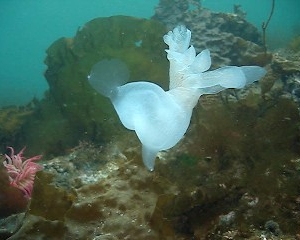
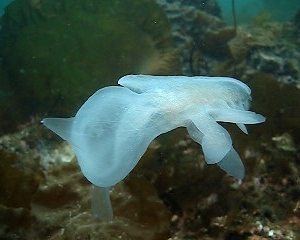
Concerning message #21158:
Our photos of Gastropteron pacificum swimming are not very good but you might be intersted in these frames I have isolated from video Glen took of a Melibe leonina swimming.
Locality: Bear Cove, 25 feet, British Columbia, Canada, Pacific Ocean, 09 April 2007 , Rocky bottom. Length: 15 cm. Photographer: Glen Miller .
Jackie Hildering & Glen Miller
earthlingenterprises@telus.net
Hildering, J. & Miller, G., 2007 (Nov 24) Re: Melibe leonina - locomotion. [Message in] Sea Slug Forum. Australian Museum, Sydney. Available from http://www.seaslugforum.net/find/21179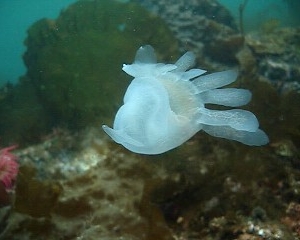
Dear Glen and Jackie,
Thanks for thinking of us Jackie. Melibe is a nice comparison to Gastropteron because as I am sure you know, their method of swimming is quite different. In Gastropteron lateral lobes of the foot act like wings or flippers, flapping up and down to provide thrust. In Melibe the whole body flattens so it looks like a vertical board turning the whole body into a blade which bends sideways to provide thrust. Bornella stellifer swims like this as well, as do some species of the quite unrelated dorid genus Plocamopherus.
A species of Bornella, has taken this a step further and instead of having a single bend in each swimming stroke it sends a wave of bends down its body so it swims like a snake or eel. Scott Johnson gave it the very appropriate name Bornella anguilla [anguilla = eel].
Best wishes,
Bill Rudman
Re: Melibe leonina - egg laying
July 10, 2007
From: Jackie Hildering
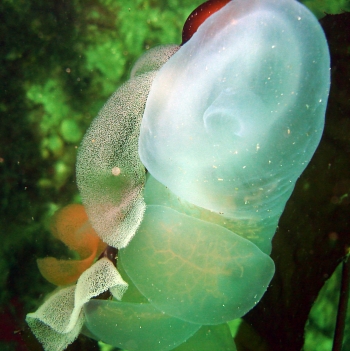
Concerning message #15968:
Thought it might be of interest for the Forum to have these images of Melibe leonina that show that this species' egg masses can also be quite an intense orange colour.
My intent is to contribute photos(especially of egg laying behaviour) and not tax the Forum with too many questions but . . . any ideas why there might be this variation in egg mass colour?
Locality: Bear Cove, 34 feet, British Columbia, Canada, Pacific Ocean, 22 April 2007, Wall . Length: 15 cm. Photographer: Jackie Hildering.
Jackie Hildering & Glen Miller
earthlingenterprises@telus.net
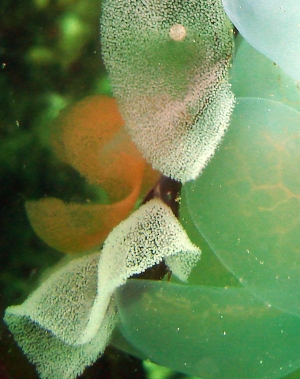
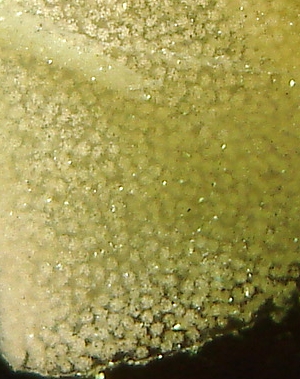
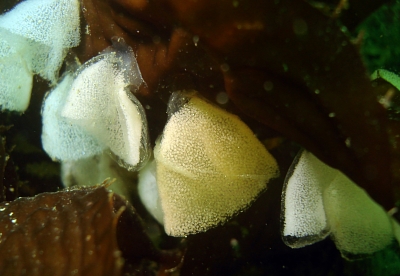
Dear Jackie and Glen,
Thanks for the great photos. We always appreciate new observations on the Forum.
Your question is a good one. Usually when individuals lay a series of ribbons like these, the coloration is identical. Sometimes the density of eggs within the mass can give a different look, but I don't see that here. Were all these masses laid by the same individual? Generally egg ribbons become smaller and less dense as a series is laid.
I hope this helps a little,
Dave Behrens
Melibe leonina fragrance
May 26, 2006
From: Dave Behrens
Hi Bill:
I was lecturing at Scripps Aquarium today and one of the aquarists asked me what the fragrant smell that their Melibe leonina gives off was for. Well, I responded that I did not realize Melibe had an odor. She took me behind the scenes at the aquarium where I grabbed a specimen out of their display and indeed, the specimen had a very strong pungent perfume-like fragrance. Quite a pleasing aroma actually.
We experience this with the dorid, Acanthodoris lutea in California, but I am not aware of any dendronotids that secrete aromatic substances. Have you or any of the Forum participant’s information on this phenomenon, in dendronotids?
Thanks
David Behrens
dwbehrens@comcast.net
Behrens, D.W., 2006 (May 26) Melibe leonina fragrance. [Message in] Sea Slug Forum. Australian Museum, Sydney. Available from http://www.seaslugforum.net/find/16667Dear Dave
Have a look at the Melibe leonina Fact Sheet where I note that Sandra Millen reports it. I have had a quick search of the literature and find a couple of references which show that the smell is caused by an aldehyde which Melibe makes from scratch. That is, it doesn't just steal a useful molecule from someone else, which is the usual nudibranch trick.
- Ayer, S.W. & Andersen, R.J. (1983) Degraded monoterpenes from the opisthobranch mollusk Melibe leonina Cellular and Molecular Life Sciences (CMLS), 39(3): 255 - 256.
[Summary: 2,6-dimethyl-5-heptenal and 2,6-dimethyl-5-heptonic acid were isolated from skin extracts of the nudibranch Melibe leonina. The aldehyde (first molecule) is responsible for the pleasant odour of the animals.] - Barsby, T. Linington, R.G., & Andersen, R.J. (2002) De Novo terpenoid biosynthesis by the dendronotid nudibranch Melibe leonina. Chemoecology, 12(2): 199-202
[Summary. Show that 2,6-dimethyl-5-heptenal, a putative defensive allomone, is made by Melibe leonina via de novo biosynthesis.]
Bob Burn notes that the small Australian species Melibe australis also produces a sweet musky smell when handled out of water. I have not noticed it when I have handled them, but that may be because I treat them very carefully as I am always scared they will drop all their cerata. Perhaps the synthesis of this sweet smelling aldehyde is found in many species of the genus. certainly something to look out for.
Best wishes,
Bill Rudman
Melibe leonina - egg laying
March 1, 2006
From: Jan Kocian
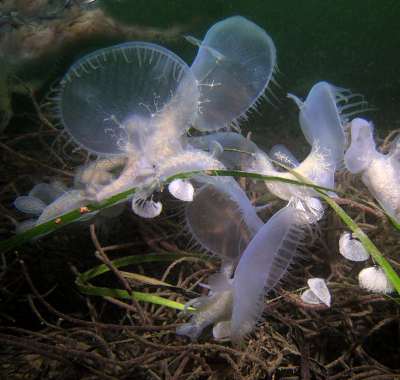
Hello Bill,
it sure seems like a weekly report on the lives of Melibe leonina is in order, always something new to report. Well, the slugs are now in tight groups and producing eggs. When I first found them, they were so the life cycle of one generation might be entering its final stage. I will keep the vigil on.
Locality: Harbor, 15 feet, Washington USA, Puget Sound,NE Pacific Ocean, 25 February 2006, Eel grass area. Length: 30 mm. Photographer: Jan Kocian.
Regards,
Jan
honkoc@hotmail.com
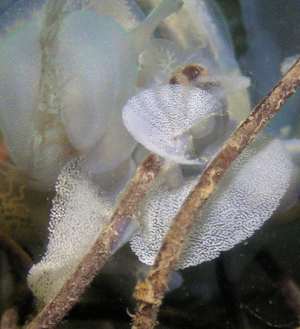
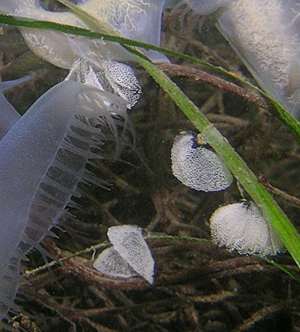
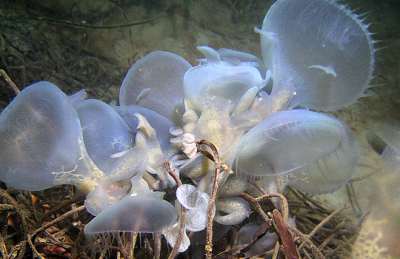
Dear Jan,
Thanks again. I will be sad when their life cycle reaches its inevitable conclusion. I hope your regular reports on one species will encourage others to concentrate on life history studies of even their most common animals. I must say however, that the peculiar shape and feeding behaviour of Melibe give it a 'special uniqueness' - which may be a tautonymy - but if so, a very deserved one.
Best wishes,
Bill Rudman
Melibe leonina mating
February 21, 2006
From: Jan Kocian
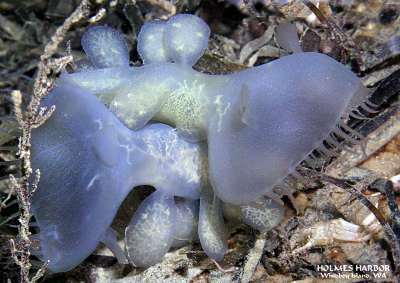
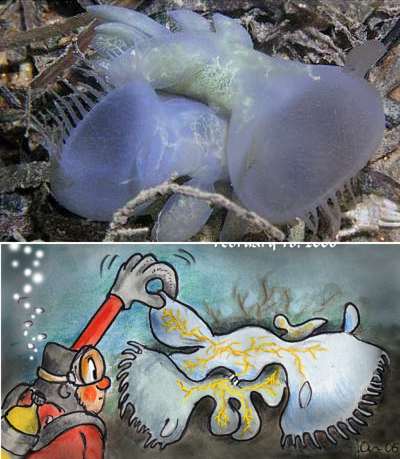
Hello Bill,
I give you credit, you do know your slugs. When in my last message [#15842] about the beginning of the die-out of local Melibe leonina population, you correctly questioned the lack of egg laying during my weekly visits to the Eel Grass patch. Well, I am happy to report, that I am seeing some action in that direction now, not massive yet, but the little cones are staring to appear. And I think I finally managed to get a picture of pair mating, so more eggs might be in the future. The dying last week could have been related to the stormy weather we experienced then, I don't know. I will keep you posted.
Locality: Harbor, 20 feet, WAshington USA, Puget Sound, NE Pacific Ocean, 18 February 2006, Eel grass area. Length: 35 mm. Photographer: Jan Kocian.
Is there anything else I should be looking out for?
Cheers,
Jan
honkoc@hotmail.com
Kocian J., 2006 (Feb 21) Melibe leonina mating. [Message in] Sea Slug Forum. Australian Museum, Sydney. Available from http://www.seaslugforum.net/find/15904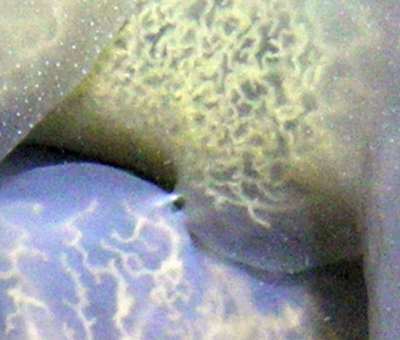
Dear Jan,
I'm glad to hear that death has been postponed. You have definitely photographed them mating. As to what else you should be looking out for, I can't think of anything - if we had observations like this on populations of other nudibranchs we would be very happy.
Best wishes,
Bill Rudman
Re: Melibe leonina clustered
February 21, 2006
From: Nicole LaForge
Concerning message #15776:
Mating may not have been observed in this case, but there appears to be a Melibe egg mass attached to the Zostera in the upper right of the first photograph. That would seem to confirm that their clustering behaviour is reproductive in nature.
Nicole LaForge
nlaforge@uvic.ca
LaForge, N., 2006 (Feb 21) Re: Melibe leonina clustered. [Message in] Sea Slug Forum. Australian Museum, Sydney. Available from http://www.seaslugforum.net/find/15874Thanks Nicole,
Yes I had missed the egg mass. You are probably correct in assuming the egg mass suggested a reproductive stage has been reached in the population, and another message from Jan, which I am posting today [#15904 ] certainly confirms that.
Best wishes,
Bill Rudman
Melibe leonina - the bell tolls?
February 17, 2006
From: Jan Kocian
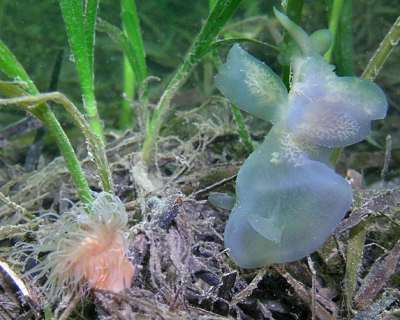
Greetings,
Just a short note from Whidbey, my weekly visit to the Melibe leoninacolony in Holmes Harbor is showing the beginning of the end of life cycle of
the slugs I became now so attached to. I see many of their bodies floating
lifeless in the water column, some are slumbered on the Eel Grass while
others are on the sea floor. There are still many hundreds alive and
seemingly well, but this is the first time I see numbers of dead slugs.
Locality: Holmes Harbor, 18 feet, WAshington, USA, Eastern Pacific Ocean, 11 February 2006, Eel grass area. Photographer: Jan Kocian.
Also in the deeper portion of the area I saw number of them swimming in open water, I don't really know the significance of it.
I will sure miss them.
I will keep you posted.
Jan
honkoc@hotmail.com
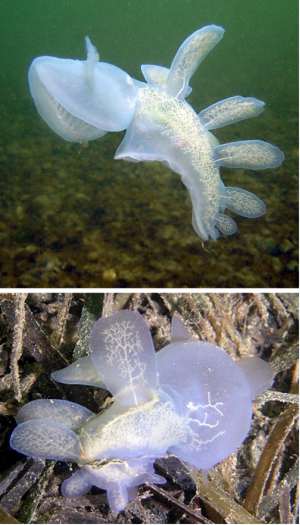
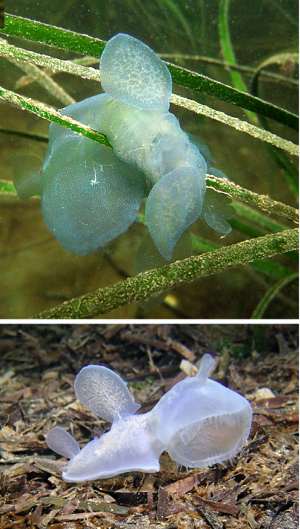
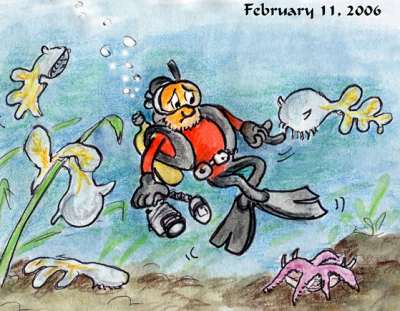
Dear Jan,
I know it's a natural part of the life cycle, but it will be quite sad to see them die off - your animals have almost become 'part of the family'. Looking back over your messages one puzzling thing is the lack of any large scale egg laying? Have I missed a message or have they missed a vital stage in their life cycle?
Best wishes,
Bill Rudman
Melibe leonina clustered
February 16, 2006
From: Jan Kocian
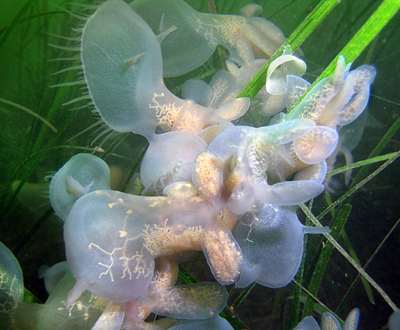
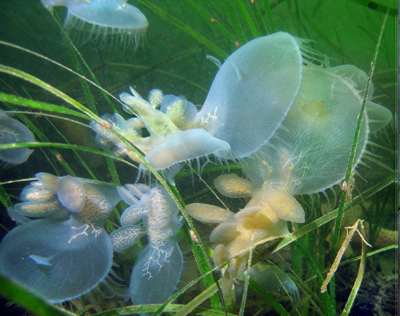
Hello Bill,
ever since I discovered the multitudes of Melibe leonina in Eel Grass patch near my home on November 9, 2005, I make a point to check on them at least once a week. They keep providing me with hours of fascination, I became quite attached to them by now as you probably figured yourself from all the stuff I keep sending your way.
Locality: Harbor, 18 feet, WAshington USA, Eastern Pacific Ocean, 05 February 2006, Eel grass area. Length: 40mm. Photographer: Jan Kocian
So as of February 5, 2006, they are still as numerous. Now I am finding some of the Melibe huddled in tight clusters, cannot clearly identify them as mating. They just keep opening and closing their hooded heads, hoping for morsels of food coming on the current.
Jan
honkoc@hotmail.com
Kocian, J., 2006 (Feb 16) Melibe leonina clustered. [Message in] Sea Slug Forum. Australian Museum, Sydney. Available from http://www.seaslugforum.net/find/15776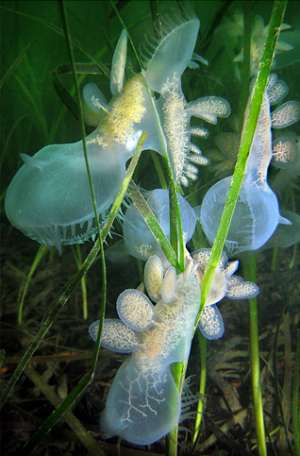
Dear Jan,
Your illustrated reports have certainly opened our eyes to just how abundant your Melibe leonina can be. I have included more of your photos - and your humour - in a second message [#15837].
Best wishes,
Bill Rudman
Melibe leonina pair
January 25, 2006
From: Jan Kocian
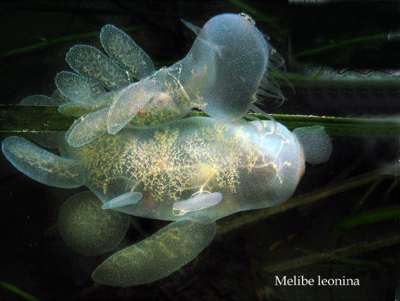
Hello Bill,
In November last year I was still enjoying the multitudes of Melibe leonina in local harbor, I came across one pair which was interested more in each other then in feeding , which seem to be the only thing the other hundreds of Melibes were engaged around them. However I don't think they were mating, since their heads were side by side. Do all nudibranchs mate in head - tail position?
Locality: Whidbey Island, Puget Sound, WAshington USA. Depth: 18 feet.
Length: 40 mm. 17 November 2005. Eel grass area. Photographer: Jan Kocian
Jan Kocian
honkoc@hotmail.com
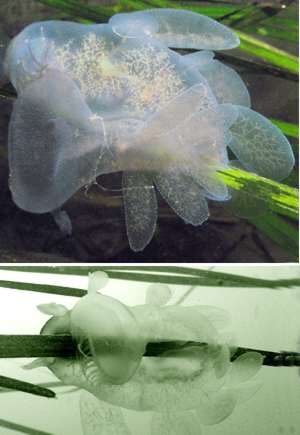
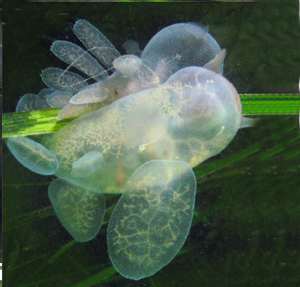
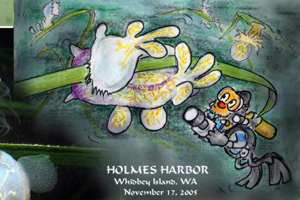
Dear Jan,
If two nudibranchs are together on the same surface then the only way they can have their right sides together is to arrange themselved head to tail. However if they are on opposite sides of the same stalk or leaf, as in your photos, then as long as the posterior half of their bodies is attached - sole to sole - then with a little contortion, their front right sides would easily be able to 'get together' when they are head to head. I don't know if they have succeeded in your photos, but they certainly seem to be trying hard.
Best wishes,
Bill Rudman
More photos of Melibe leonina
January 19, 2006
From: Jan Kocian
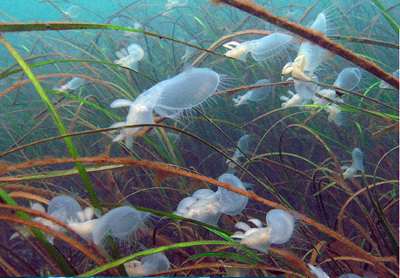
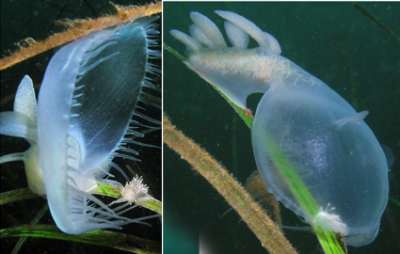
Hello Bill,
I can only imagine the work associated with running such far reaching project as Slug Forum is. I am still so amazed by the brilliant way to share information about slugs and encompass all levels of expertise (or the lack of). Of course, if you like to post the artwork on the Forum, I will be honored. So again, wish you good health and keep up the great work.
Melibe leonina was still plentiful in December here, so enclosed are some more photos.
Locality: Puget Sound, Washington, USA. Pacific Ocean. in sea grass beds. December 2005. Photographer: Jan Kocian
Jan Kocian
honkoc@hotmail.com
Kocian, J., 2006 (Jan 19) More photos of Melibe leonina. [Message in] Sea Slug Forum. Australian Museum, Sydney. Available from http://www.seaslugforum.net/find/15431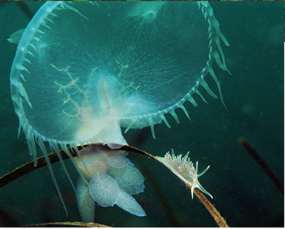
Dear Jan,
This message missed the Christmas rush - but better late than never. As you will see I've pulled out some of your earlier artwork. It deserves a wider audience than me.
Concerning the Melibe photos. I know in words that this species occurs in large numbers but your photo above really shows how dangerous it is to be a little planktonic animal - and even a crawling one - when Melibe leonina is in abundance.
Best wishes,
Bill Rudman
Parasite or hitchhiker? on Melibe
January 18, 2006
From: Jan Kocian
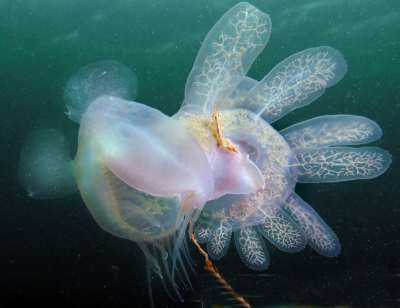
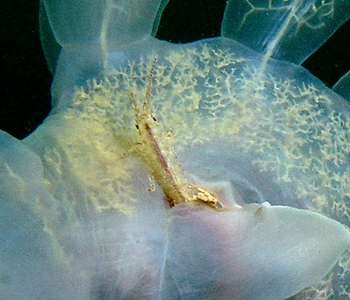
Hi Bill,
I came across a swimming Melibe leonina harboring this little critter, I think it is just an accidental traveler since I did not see any other slugs in the group with same.
Locality: Whidbey Island, Puget Sound, WAshington, USA. Nth-eastern Pacific Ocean. Depth: 15 feet. Length: 40 mm. 09 November 2005. Eel grass area. Photographer: Jan Kocian
Jan
honkoc@hotmail.com
Kocian J., 2006 (Jan 18) Parasite or hitchhiker? on Melibe. [Message in] Sea Slug Forum. Australian Museum, Sydney. Available from http://www.seaslugforum.net/find/15247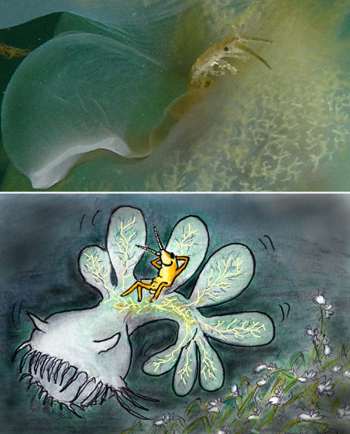
Dear Jan,
I passed this on to a crustacean expert, who by chance was in the USA for a couple of months and has only recently returned. He tends to think your animal is an isopod crustacean, but doesn't recognise a family grouping from the photos. He would need a specimen to identify it but as I told him, the specimen cruised past some time ago. I tend to agree with your suggestion that this is not a regular association. Considering Melibe's partiality for small crustacea, I think it may have a death wish
Best wishes,
Bill Rudman
Melibe leonina on Eel Grass
October 14, 2005
From: Jan Kocian
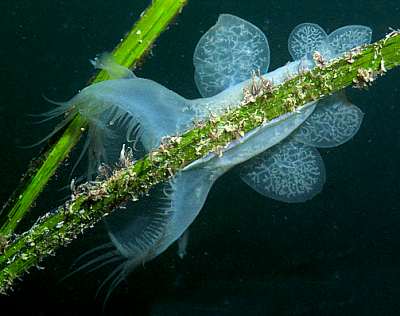
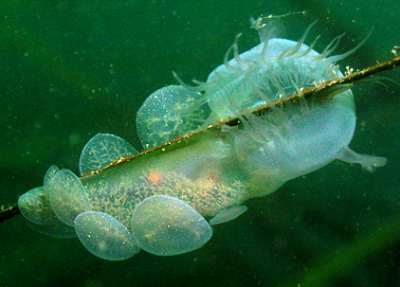
Hello Bill,
More photos of Melibe leonina, this time feeding (?) off Eel grass (Zostera marina).
Locality: Puget Sound, Washington, USA, NE Pacific Ocean. Depth: 20 feet
Length: 35 mm. 07 October 2005. Photographer: Jan Kocian
Jan
honkoc@hotmail.com
Kocian J., 2005 (Oct 14) Melibe leonina on Eel Grass. [Message in] Sea Slug Forum. Australian Museum, Sydney. Available from http://www.seaslugforum.net/find/14953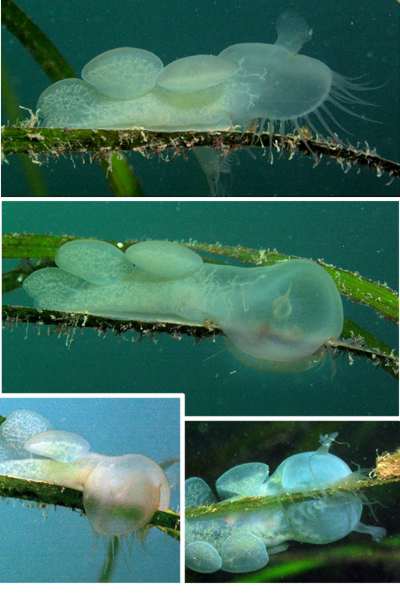
Dear Jan,
I must say that species of Melibe are one of my most favourite animals. Their shape is so unbelievable - but clearly very efficient. You ask if they are 'feeding off' the Eel Grass. If you mean are they eating the Eel Grass, then the answer is no. They have no teeth or hard parts so biting off bits of plant material is out of the question. All species that have been looked at feed in small crustacea - crabs, shrimps, copepods, amphipods etc, which they catch in their remarkable fishing net-like oral hood. Most species feed on crustacea living on the sand or substrate which they catch by feeling with the papillae (or feelers) along the edge of their oral hood, closing the hood around the prey and swallowing it whole. Melibe leonina also catches planktonic animals drifting past by holding its head out into the water current.
In your wonderful photos, the animal it is 'slurping' along the Zostera leaves attempting to catch any small crustacea living amongst the organisms growing on the leaves.
Best wishes,
Bill Rudman
Re: Melibe leonina loses cerata [1]
October 6, 2005
From: Ingo Burghardt
Dear Bill and Jan,
I just saw your mail concerning Melibe leonina on the Forum [message #14867]. We kept Melibe engeli for several months in our lab and some of the specimens detached cerata. They regrew all cerata after some time, althought the second cerata were smaller and differently shaped. They are really amazing creatures!
Unfortunately I didn't take any fotos of the new cerata.
Cheers,
Ingo
ingo.burghardt@rub.de
Burghardt, I., 2005 (Oct 6) Re: Melibe leonina loses cerata [1]. [Message in] Sea Slug Forum. Australian Museum, Sydney. Available from http://www.seaslugforum.net/find/14925Thanks Ingo,
Bill Rudman
Melibe leonina loses cerata [1]
October 1, 2005
From: Jan Kocian
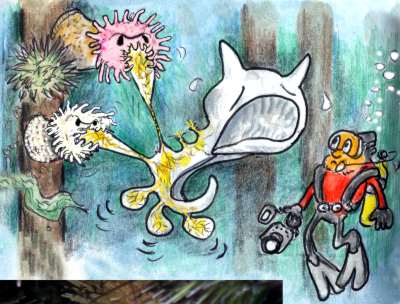
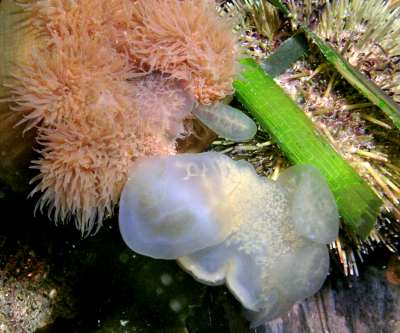
Hello Bill,
I had an interesting encounter with Melibe leonina. Carried by the current, it was swimming by , its body flip-flopping back and forth. I decided to follow it on its journey through the pilings beneath the the old wharf. In spite of the strong current, it managed to land on leeward side of one of the pilings and start to explore area where a piece of kelp stuck on some of the Green Sea Urchins. The eddies dislodged the slug and it landed on one of sea anemones also thriving on the piling. By wriggling around and detaching some of its cerata the slug got away only to land on second anemone. Again, after some maneuvering it got free, but only two cerata left on its body. From here it continued to swim away, this time avoiding the rest of pilings. I wonder if it can survive with this many cerata missing..
Locality: Whidbey Island, Puget Sound, Washington, USA. Pacific Ocean.
Depth: 15 feet. Length: 2 inches. 24 September 2005. old wharf. Photographer: Jan Kocian
Jan.
honkoc@hotmail.com
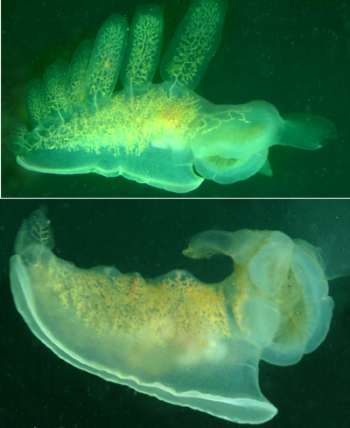
Dear Jan,
Firstly, thanks for the wonderful cartoon! I'll have to make you the Forum's 'official cartoonist' - no salary unfortunately. Thanks also for the interesting observation and photos. I've include some in a second message [#14889 ] as we have to restrict the number of images per message.
Species of Melibe, and some other opisthobranchs are able to drop some of their cerata, and other body parts as a defensive measure - a bit like some lizards drop their tails. It is called autotomy. Not much is known about regrowth of body parts. There is a big paper by Bickell-Page (1989) on ceratal autotomy, which investigates the complex processes in both the nervous system and the muscles, which is needed for autotomy to occur. But from memory I am pretty sure no mention is made of regrowth. However there is a paper on ceratal loss in our old friend Hermissenda crassicornis (see Miller & Byrne, 2000) which did study regrowth, and they showed that Hermissenda can fully regrow its cerata in about 40 days. An earlier study by Kress (1968) on a number of species of Doto, showed it took between 30 and 60 days for full regrowth depending on the species. When you think this means regrowing the internal digestive gland as well as the cerata, with all the skin glands etc, it is quite a complex process. Most nudibranchs can survive periods of starvation, often by absorbing their gonads so I suspect no great harm will come to the Melibe as it regrows its cerata. As you can see in your photo, Melibe leonina also has branches of the digestive galnd in its body wall as well as the cerata, so its not totally bereft of a gut even when it loses its cerata.
-
Bickell-Page, L. R. (1989) Autotomy of cerata by the nudibranch Melibe leonina (Mollusca): ultrastructure of the autotomy plane and neural plane and neural correlate of the behaviour. Philosophical Transactions of the Royal Society of London, B 324: 149-172.
-
Kress, A. (1968) Untersuchungen zur histologie, autotomie und regeneration dreier Doto-Arten Doto coronata, D. pinnatifida, D. fragilis (Gastropoda, Opisthobranchia). Revue Suisse de Zoologie 75: 235-303.
-
Miller, J. A. and Byrne, M. (2000) Ceratal autotomy and regeneration in the aeolid nudibranch Phidiana crassicornis and the role of predators. Invertebrate Biology 119: 167-176.
Best wishes,
Bill Rudman
Melibe leonina loses cerata [2]
October 1, 2005
From: Jan Kocian
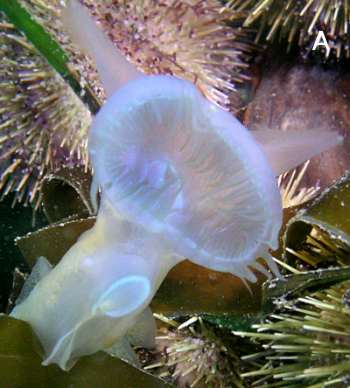
Here are some more of Jan Kocian's photos to accompany his message [#14867] about Melibe leonina being washed into the 'jaws' of two sea anemones.
Locality: Whidbey Island, Puget Sound, Washington, USA. Pacific Ocean.
Depth: 15 feet. Length: 2 inches. 24 September 2005. old wharf. Photographer: Jan Kocian
A. Ventral view up into oral hood, showing sensory papillae lining the inside edge of the opening and the whitish opening of the true mouth.
B. Side view showing ramifying network of digestive gland ducts in both both wall and cerata.
C. Dorsal view of head. The orange mass in the 'neck' region is the ring of nerve ganglia which can be called the slugs' brain. The two thin white threads running forward from the brain are large nerves connecting to the rhinophores.
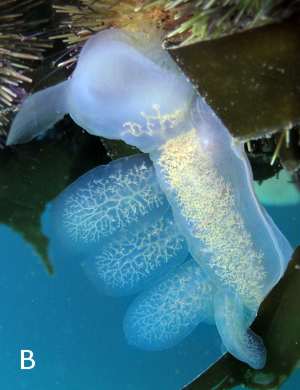
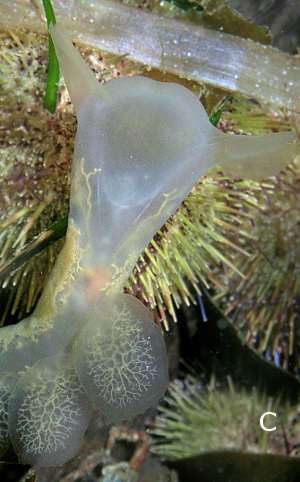
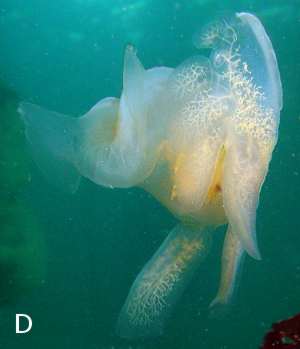
D. Animal, drifting and swimming, in the currents before the calamity with the sea anemones.
Melibe leonina from Puget Sound, Washington
September 19, 2005
From: Jan Kocian
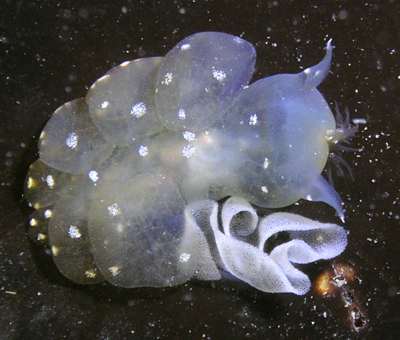

Enclosed couple photos of Melibe leonina with ribbon of eggs . I found them on kelp near Keystone Jetty, Whidbey Island. They seem to appear at this location in September and October and then disappear again for the rest of year.
Locality: Artificial reef, Whidbey Island, Washington, USA. Eastern Pacific Ocean. Depth: 25 feet. Length: 1 inch.15 September 2005. jetty. Photographer: Jan Kocian
Jan Kocian
honkoc@hotmail.com
Kocian, J., 2005 (Sep 19) Melibe leonina from Puget Sound, Washington. [Message in] Sea Slug Forum. Australian Museum, Sydney. Available from http://www.seaslugforum.net/find/14789Thanks Jan,
Your animals have the same white patches as in Marli Wakeling's earlier photos [#10999]. It would be interesting to know what they are.
Best wishes,
Bill Rudman
Transparent sea creature from Alaska
August 18, 2005
From: Ron Matecki
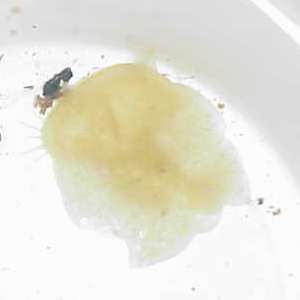
Hi.
I'm sending a photo of a small creature that I found living near my float. I'd never seen this creature before and I was hoping that you might be able to identify it.
Locality: SE Alaska (klawock), USA. Depth: 1 to 3 inches. Length: 2 inches
15 Aug 2005. muddy, inside waters. Photographer: Ron Matecki
This creature is transparent.
Thanks in advance,
Ron
ronmatecki@planet-save.com
Matecki, R., 2005 (Aug 18) Transparent sea creature from Alaska. [Message in] Sea Slug Forum. Australian Museum, Sydney. Available from http://www.seaslugforum.net/find/14584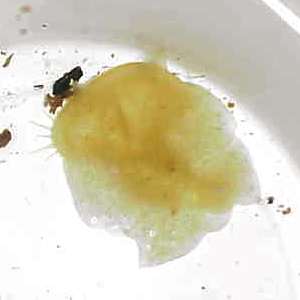
Dear Ron,
I've doctored your photo a bit to show some of the detail - photographing transparent animals in a white bucket is not that easy. It is Melibe leonina. If you look at the species Fact Sheet, and some of the attached messages, you should find quite a bit of information on the fascinating animal, which uses the large oral hood as a shrimp net.
Best wishes,
Bill Rudman
Life expectancy of Melibe leonina
June 7, 2005
From: Steve Johnston
Does any body have any data as to the life expectancy for Melibe leonina? None of my printed sources discuss that, so maybe there hasn't been much research in that area. I'm hoping someone out there has a clue!
Thanks,
Steve Johnston
Senior Interpreter
Monterey Bay Aquarium
sjohnston@mbayaq.org
Johnston, S., 2005 (Jun 7) Life expectancy of Melibe leonina. [Message in] Sea Slug Forum. Australian Museum, Sydney. Available from http://www.seaslugforum.net/find/13945Dear Steve,
I summarised in an earlier message #3511 what we know of this animal's life cycle. I don't think longevity has been studied. Hopefully someone will be able to help us.
-
Ajeska, R A. & Nybakken, J (1976) Contributions to the biology of Melibe leonina (Gould, 1852). The Veliger, 19(1): 19-26.
Best wishes,
Bill Rudman
Melibe leonina larvae
March 8, 2004
From: Jen Massey
I'm trying to find out what the larvae of Melibe leonina eats ... any hints or references?
Thanks
Jen
jmassey@ucsc.edu
Massey, J., 2004 (Mar 8) Melibe leonina larvae. [Message in] Sea Slug Forum. Australian Museum, Sydney. Available from http://www.seaslugforum.net/find/12368Dear Jen,
Although all nudibranchs are carnivorous, their larvae, if free-swimming, all feed on single-celled algae. Usually in laboratories, commercial single species cultures are used.
You are fortunate that Melibe leonina is one of the few species whose larval development and metamorphosis has been studied in any depth. Bickell & Kempf (1983) fed their veliger larvae a commercial alga culture of Pavlova (Monochrysis) lutheri and when they metamorphosed into tiny crawling slugs, fed them unidentified ciliates which were cultured on rotting animal tissue, and supplemented this diet with the nauplii larvae of harpacticoid copepods.
• Bickell, L.R. & Kempf, S.C. (1983) Larval and metamorphic morphogenesis in the nudibranch Melibe leonina (Mollusca: Opisthobranchia). Biological Bulletin, 165: 119-138.
Are you planning to culture them yourself? If so, keep in touch, and let us know how you go.
Best wishes
Bill Rudman
Melibe leonina from British Columbia
October 24, 2003
From: Bruce Wight
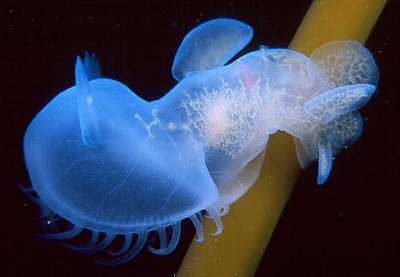
Dear Bill
Here are some photos of Melibe leonina from our recent trip to British Columbia.
Johanna and I were up at the Northern end of Vancouver Island the first week of October diving around Port Hardy and Browning Pass, British Columbia. This was our first time diving in Canada.
The Melibe leonina appear much bluer and vascular than the ones I have seen off California. The Melibe stayed in the protected coves on the kelp for the current easily dislodged them. We saw many, from the boat, drift by in the swift water of the channels during periods of heavy current.
Take care,
Bruce Wight
bwproductions@earthlink.net
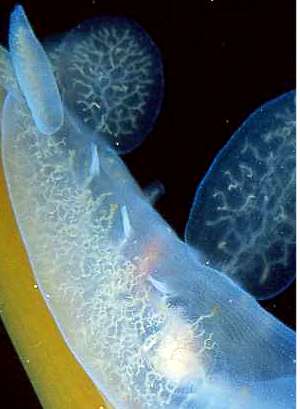
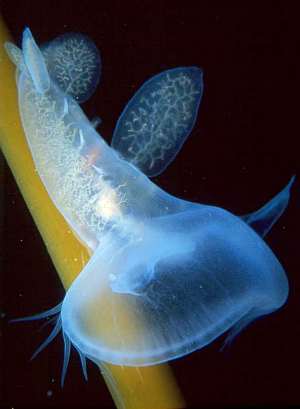
Thanks Bruce
They are fascinating animals. You certainly can see the branching digestive gland very clearly in these animals. Apparently you saw no sign of the white patches that Marli Wakeling reported recently.
Best wishes
Bill Rudman
Re: Melibe leonina from British Columbia
September 29, 2003
From: Alicia Hermosillo
Dear Bill,
I was looking at these pictures of Melibe leonina. I have also seen some with the big white blotches and some without. If anyone else out there dives in giant kelp, they will see how the kelp deteriorates and gets those white blotches as well. I do not know what their nature is either.
Alicia Hermosillo
gueri25@hotmail.com
Hermosillo, A., 2003 (Sep 29) Re: Melibe leonina from British Columbia. [Message in] Sea Slug Forum. Australian Museum, Sydney. Available from http://www.seaslugforum.net/find/11049Thnaks Ali,
Bill Rudman
Melibe leonina from British Columbia
September 25, 2003
From: Marli Wakeling
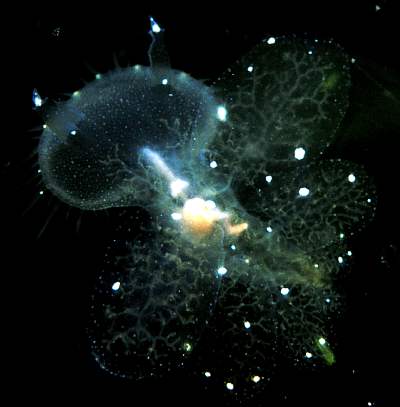
Hi Bill,
These Melibe leonina were found in shallow water at God's Pocket Resort near Port Hardy, British Columbia. Is there a purpose to the blue-white dots? They were not visible on all the animals present, and seemed to be brighter on the smallest ones. The animal in the Upper right Photo is very small, only 1.5 cm., while the others ranged up to 15cm. in size.
Looks like one is waving hello!
Date: August 25, 2003
Dive Site: God's Pocket Bay
Depth: 20 feet
Photos: Marli Wakeling
Marli Wakeling
scubamarli@excite.com
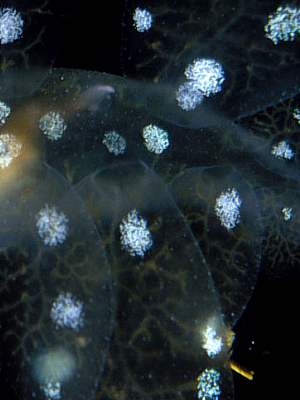
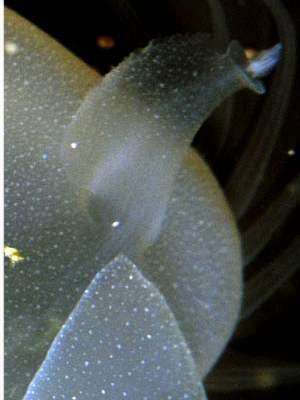
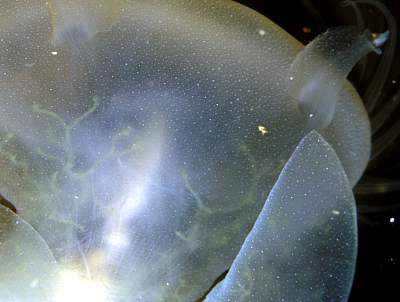
Dear Marli,
The little white spots are almost certainly glandular, but I have no idea what the large white speckled patches are. There is always the possibility that they are some minute flatworm infesting the slugs but that is just a guess.
I have included a closeup of the rhinophore and its very characteristically shaped sheath
Best wishes
Bill Rudman
Re: Mystery from Puget Sound, Washington
May 14, 2003
From: Melissa
Thank you for taking the time to answer my question of the mystery nudibranch found in the Pacific Northwest. Upon further investigation and re-capturing a specimen, I also concluded that the animal was Melibe leonina. I enjoyed using your site as a resource.
Melissa
melissab@lummi-nsn. gov
Melissa, 2003 (May 14) Re: Mystery from Puget Sound, Washington . [Message in] Sea Slug Forum. Australian Museum, Sydney. Available from http://www.seaslugforum.net/find/9945Mystery from Puget Sound, Washington
May 7, 2003
From: Melissa
I do research in northern Puget Sound, Washington. I am not a marine, but estuarine expert. In the field yesterday, I came across a nudibranch-type specimen that I have not been able to find in any of my hard copy or online field guides or keys.
I was in knee-deep, soft-substrate intertidal habitat when I spotted two soft-bodied, transparent, purple colored molluscs of the same species. The larger of the two measured about 10 cm in length. It had three (gills?) round but dorsal-ventrically compressed appendages on each side, mid body. It's tail was classic nudibranch shaped, but the anterior end was hollow and ring-shaped, also dorsal-ventrically compressed. It swam using lateral head/tail movements; the smaller one was not so active. It surfaced and swam to the bottom (shallow water), where the benthic surface was spotted with green algae.
Melissa
melissab@lummi-nsn.gov
Dear Melissa,
The only thing I can think of which fits your description is Melibe leonina, but I don't know if I would describe its colour as purple although I guess the iridescent sheen which appears on the skin in certain lights, could be described as purple. Let me know if I've guessd correctly
Best wishes,
Bill Rudman
Melibe project
May 11, 2001
From: Kenny Cottrell
Hi,
I am doing a poster project on Melibe leonina. I am having trouble finding out what Melibe eats (specifically) and get's eaten by. If you can help me with my info that would be a great help. Any other information would be great.
bye,
Kenny
bustit@uprock.com
Cottrell, K., 2001 (May 11) Melibe project. [Message in] Sea Slug Forum. Australian Museum, Sydney. Available from http://www.seaslugforum.net/find/4318Dear Kenny,
Apparently you didn't find the page on Melibe leonina. Have a look there and at the messages attached at the bottom of that page (below your message) and I think you will the information you are looking for. In particular have a look at my reply to William Cullen's message.
If you are looking for things in the Forum you can use the SEARCH button, or any of the other buttons at the top of this page. You can also click on any underlined word as well.
Good Luck with your project,
Bill Rudman
Melibe leonina back at Del Monte
March 7, 2001
From: Clinton Bauder
Dear Bill,
I have it on good authority that the local population of Melibe leonina has reappeared at the shale beds off of Del Monte beach after an absence of many years. I'm going to check it out personally but I figured Monterey area branchers might want to know about it.
Clinton
gecko1@apple.com
Bauder, C., 2001 (Mar 7) Melibe leonina back at Del Monte. [Message in] Sea Slug Forum. Australian Museum, Sydney. Available from http://www.seaslugforum.net/find/3928Re: Melibe leonina from Alaska
January 17, 2001
From: William Cullen
Dear Bill,
I didn't know you lived on the other side of the world. Thank you for the information, there was a lot of good stuff. My whole family enjoyed it. We don't have an underwater camera yet that will work, but we will send a photo when we get one. We are writing a book about sailing on Prince William Sound. I would like to share a poem my sister Sherstin wrote about Melibe leonina
Here she is like flower in the Wind
Silent as a ghost, yet drifting.
Drifting with all the grace and tranquility no other Nudibranch could have
Yet she is not Vain
Still she drifts, opening her purse net to catch the plankton that feeds
her small clear body.
She gently lands on a piece of Eel grass and stands with all the grace
and dignity of a lion
Remember, Leonina means little lion.
I'll send you a picture when I can, probably this summer. That's this winter for you.
Sincerely,
William
cullenmd@alaska.net
Cullen, W., 2001 (Jan 17) Re: Melibe leonina from Alaska. [Message in] Sea Slug Forum. Australian Museum, Sydney. Available from http://www.seaslugforum.net/find/3557Dear William,
Please thank Sherstin for the wonderful poem. It must be one of the very few poems about sea slugs. I look forward to your photos.
Best wishes,
Bill Rudman
Re: Melibe from Alaska
January 12, 2001
From: William Cullen
Dear Bill,
We see a lot of Melibe leonina in Prince William Sound in Alaska, which is farther North than Kodiak. We find them in shallow water anchored to Eel Grass, sometimes numbering in the thousands. I am doing a report on M. leonina for school. Do they have predators? My books say they are rarely eaten. Are they poisonous? Can people eat them? Is their larval stage different than their adult stage? What do they use their tentacles for, the ones on the oral hood? What are their cerata used for? My family finds them interesting.
William Cullen [age 8]
cullenmd@alaska.net
Cullen, W., 2001 (Jan 12) Re: Melibe from Alaska. [Message in] Sea Slug Forum. Australian Museum, Sydney. Available from http://www.seaslugforum.net/find/3511Dear William,
Although I have never seen it alive, from what I have read and seen in photographs, I can well understand why you and your family find Melibe leonina fascinating. Quite a few people have studied aspects of its biology and I have listed most of the background information on the M. leonina references page. I am not sure how familiar you are with using webpages so in case you aren't very familiar, if you click on any underlined word, which will probably also be in a different colour, you will open another page on that topic.
To answer your questions. The larvae of all nudibranchs, all molluscs in fact, are quite different from the adults. They are called veligers, and have a shell and a large bilobed ciliated flap (velum) on the head which is used for swimming and for catching the microscopic plants that veligers all feed on. If you go to the General Topics List and look at the pages listed under 'larvae, larval development etc' you will find some photos of veliger larvae and how they develop into slugs. Also have a look at some good photos of the larvae of Hypselodoris zebra. In general if you want to look for things on the Forum use the SEARCH button at the top and bottom of each page and type in the word you are interested in.
Now getting back to Melibe. Veliger larvae hatch from their eggs about 10 days after laying. Like all veligers, they have a shell, operculum, velum etc., and they swim in the plankton where they feed on microscopic plants (phytoplankton). After 30-59 days they are ready to metamorphose, which means they are ready to settle out of the plankton, change shape and become little crawling slugs. Most nudibranchs that have been studied, need a chemical scent in the water, usually from their food, before they begin to settle and metamorphose. In Melibe leonina however, a chemical stimulus does not seem to be necessary. Metamorphosis is a major event for all nudibranchs, because they not only have to change shape but they have to change their digestive system and how it works, because they are changing from eating plants to eating meat.
After settling on the bottom, the small slug begins to change shape. After 12-20 hours it drops its shell and it is rapidly growing its oral hood and the first pair of cerata. Within 2 and a half days the oral hood is big enough for it to catch its first meal, which because it is still very small, consists of microscopic one-celled ciliated animals.
Which brings me to your question about the tentacles on the oral hood. Melibe leonina, like all species of Melibe, uses its oral hood like a throw net in fishing, to catch its food. The fine tentacles along the edge are used to feel for prey. When prey are detected the net can rapidly close, drawing the food into its mouth. Melibe leonina eats small crustacea and other small invertebrate animals, but large and small Melibe use the hood quite differently. Larger animals (25mm or longer) feed by lifting the oral hood into the water column and waving it through the water, regularly closing it to eat any animals which have been caught. The more prey in the water, the more often Melibe will go through the feeding cycle of waving and closing the hood. Small Melibe, less than 25mm long, seem to feed quite differently. They hold the hood out horizontally, just above the bottom, and gradually move along feeling ,with the tentacles around the edge of the hood, for small prey. This is the way that other species of Melibe, such as M. engeli and M. viridis feed, even when they are much larger.
There are very few observations of animals attacking and eating M. leonina. The only one I can find reports some of them being eaten by the Kelp Crab Pugettia producta in Monterey Bay, California. (Ajeska & Nybakken). M. leonina is well-known for the characteristic citrus smell it produces when touched or when it is aggregating in large numbers. This secretion is produced by skin glands in the oral hood and cerata and consists of a weak acid and a scent. Some consider it to be defensive, and it has also been suggested that it is a sex pheromone, attracting animals together for mating, but no one really knows. I don't know of people eating it. I would suspect the secretions from its skin would make it rather distastteful.
What else can I say about it? It can swim by lateral flexion of the body, but swimming seems to be a second best way of life, probably as a result of being washed off the plants it normally lives on. I almost forgot your question about the cerata. I am not sure what their function is, but they certainly increase the surface area of skin so are important in respiration (breathing, gas exchange)and so could be thought of as gills. One other important function of the cerata is probably defence. When disturbed, Melibe can break off one or more of the cerata, which then wriggle around and exude their characteristic secretion and scent for some time. This behaviour, much like a lizard dropping its tail, is called autotomy. Have a look at the autotomy page for some other examples of sea slugs which use autotomy in their defence.
Have a look at the information and photos on other species M. engeli and M. viridis. I hope this will give you plenty of information for your project. Perhaps if you take any photos of your Alaskan animals you could send a copy to the Forum, or if you see them doing interesting things, you could let us know
Best wishes,
Bill Rudman
My name is Melibe!
December 20, 2000
From: Melibe Tardaewether
Hello!
I thought you might be interested to know that my name is Melibe. I am 22 years old and originally from Oregon. My parents named me after the Melibe leonina. Have you ever heard of any one else named Melibe? I am very curious!!
Thanks!
Melibe
melibet@eclipseinc.com
Tardaewether, M., 2000 (Dec 20) My name is Melibe!. [Message in] Sea Slug Forum. Australian Museum, Sydney. Available from http://www.seaslugforum.net/find/3397Dear Melibe,
I never thought I would ever have a conversation with a Melibe! Although they are fascinating animals and have a very clever way of catching their prey, I don't think they really have the brain capacity for language.
I hope your message doesn't start an avalanche of "My name is Doris" type messages, as I am having enough trouble with the backlog of questions on real slugs. I guess naming people after slugs is completing the circle, as many slug names are directly from the names of Greek and Roman gods and goddesses.
Best wishes,
Bill Rudman
Re: Melibe from Alaska
September 7, 2000
From: Mike Merkley
Dear Bill,
Thank you for your response to my question about the sea slug, it is greatly appreciated. It answered lots of questions and I have enjoyed learning more about it from the forum!
Thank you
Mike Merkley
bigmike535@juno.com
Merkley , M., 2000 (Sep 7) Re: Melibe from Alaska. [Message in] Sea Slug Forum. Australian Museum, Sydney. Available from http://www.seaslugforum.net/find/2979Glad to help Mike,
and thanks also to Bruce Wight who was able to rustle up some excellent photos at short notice.
Best wishes,
Bill Rudman.
Another mystery from Alaska
September 4, 2000
From: Michael Merkley
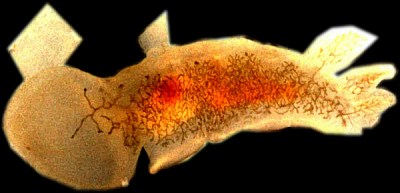
I found an unusual creature near Kodiak, Alaska and I am sending a picture to you because i don't know what it is and i can't identify it from any books. It is about six inches long and was found floating on the surface of the water in a bay. It had a jelly-fish-like body and was see through. It appeared that it had organs and a nervous system.
Its head looked like a jelly-fish in that it had a 'mouth' with tentacles around the outside (not visible in picture). It's underside had a foot like a slug, that ran the entire length of it's body and was about 1/2 inch wide. It had two 'ears' on it's head and six similar looking flippers on its tail, except the flippers on it tail had nerves in it.
Thank you so much for your time.
Michael.
bigmike535@juno.com
Merkley, M., 2000 (Sep 4) Another mystery from Alaska. [Message in] Sea Slug Forum. Australian Museum, Sydney. Available from http://www.seaslugforum.net/find/2943Dear Michael,
I am not sure what the kite-shaped thing at the left-hand end of your photo is, but I am pretty sure this is the fascinating Melibe leonina which is found from Alaska to California. It is often found attached to kelp but is also found floating/swimming freely in coastal waters. Its jellyfish-like head is in fact a large fishing net used to catch the small shrimp-like crustacea (amphipods etc) that it eats.
I asked Bruce Wight if he could provide any photos to help identify your animal and he has kindly sent me some. Thanks very much Bruce. There are already photos of a couple of species from the tropical Indo-West Pacific already on the Forum [Melibe viridis and Melibe engeli].
Best wishes,
Bill Rudman.
